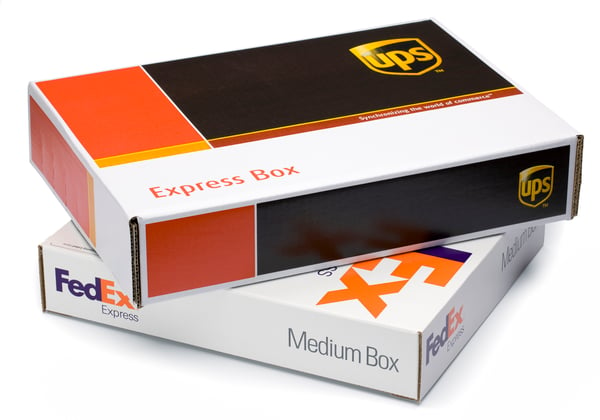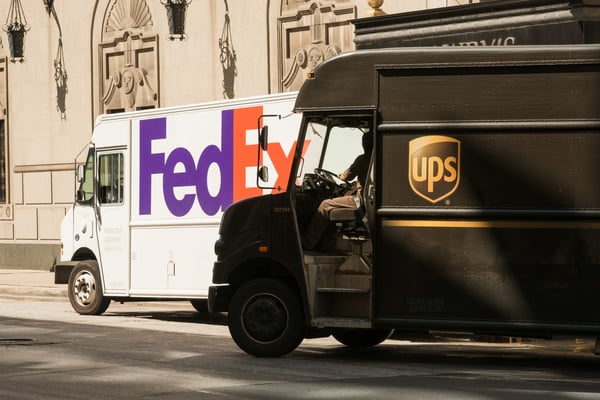
As an e-commerce merchant, your livelihood hinges on your ability to deliver orders quickly and affordably. As two of the largest carrier services in the world, UPS and FedEx are likely at the top of your list of carriers you are considering to handle your deliveries. And while they are similar in many respects, there are some key differences that can have a major impact on your business. Below is a look at the top factors to consider when deciding whether to choose FedEx vs UPS for your e-Commerce business.

Before examining the differences between FedEx vs UPS, it is helpful to review some of the key similarities between the two carriers. Both UPS and FedEx are world class companies that offer superb performance and reliability. They offer a similar collection of services and both companies generated well over $60 billion in revenue in 2018. Here is a look at some of the other similarities between UPS and FedEx:
"...To those following them (UPS and FedEx) closely, the two companies are actually quite different in their business models and strategies...The two companies also differ in terms of their approaches to serving customers, how they have fared in the e-commerce environment, and the different business structures unique to each company."
- Jay Wei, Investopedia
UPS and FedEx both offer an attractive array of services to e-commerce businesses. However, they differ in their approach to serving customers, and it is up to you as an e-commerce merchant to consider the differences in their business models and to select the carrier with the business model that best meets your needs. Here are five factors to consider as you compare FedEx vs UPS:
If you are like most e-commerce merchants, your top concern is cost. But determining which carrier will offer the best deal is not always a straightforward process. There are two key points you need to consider in order to determine which carrier offers the best price advantage for your business:
Other than cost, pickup times are perhaps the most critical factor to consider when evaluating carriers. If a carrier's regularly scheduled pickup occurs in the morning or around lunchtime, you would need to "hold" any orders received later in the day until the next business day or take those orders to the service center or drop box. In contrast, a pickup time that is too late in the day will require you to have staff on hand to wait on a driver. If your business day ends at 5:00, then a 4:30 PM pickup would be ideal.
Regardless of how hard you work to prevent delivery-related hiccups, challenges are going to arise. Drivers might be delayed due to weather or mechanical issues, or you might have a last minute order that arises after your regularly scheduled pickup has already occurred. If you frequently receive an influx of orders later in the business day, you may wish to choose the carrier with a service center that is close to your facility.
UPS and FedEx drop boxes are a convenient alternative for shipments that miss their regularly scheduled pickup. Check the drop boxes for both carriers near your facility and be sure to note the pickup times. Ideally, the carrier you choose will have a nearby drop box with the latest possible pickup time to afford you more flexibility. Find FedEx drop box locations near you. | Find UPS drop box location near you.
Ground service transit times may be an important factor to consider when choosing the best carrier for your business. Ground service transit time can impact your order your conversion rate. For example, if a carrier's 1-day footprint only encompasses the states of Kentucky and Tennessee while the second encompasses seven states, then the second option is more attractive and can give you a competitive advantage. Be sure to carefully review the ground service transit map provided by each carrier to see which carrier has the ability to reach the largest segment of your customer base within the shortest time frame. View the time-in-transit map for FedEx Ground | View the time-in-transit map for UPS Ground.

Sometimes the measures you take after you choose a carrier are just as important as those you take before you finalize your selection. Regardless of whether you choose FedEx vs UPS to handle your e-commerce shipments, you need to take the steps necessary to ensure that you are receiving the best combination of value and support for your business. Here are three tips to follow after you choose your carrier.
After you finalize your decision, you can expect the carrier you did not choose to continue to pursue your business in an effort to win you over. In some cases, these efforts will arrive in the form of attractive rate reductions or special discounts for the upcoming year.
While UPS and FedEx are both outstanding carriers, neither company is perfect. Delivery delays, shipping damage, and lost parcels are inevitable as your volume of shipped parcels grows. Be sure to keep track of your claims and how swiftly they were resolved.
Rate increases, a higher than expected number of claims, or a facility relocation are all reasons why a carrier change could be in order. Do not hesitate to consider a switch if carrier problems are causing your e-commerce business to suffer.
Choosing between two world class companies to handle your deliveries is not an easy process. While UPS and FedEx share many similarities, a closer examination of their service packages reveals some subtle differences that can impact your operations. You must carefully consider your business objectives in conjunction with your location, your customer base, and the net price of your shipments.
Navigating the complexities of the e-commerce shipping landscape will become an easier process as you gain experience as an e-commerce merchant. Check out A Beginner's Guide to E-commerce Shipping if you'd like to learn more about shipping. The Eniture Technology team is here to help you develop a strong working knowledge of e-commerce best practices related to marketing, logistics, and programming. We invite you to subscribe to the Eniture Technology blog to receive valuable updates on the latest developments in the e-commerce industry. We look forward to serving as your company's most trusted resource!
GET IN TOUCH
Phone: 404.369.0680
info@eniture.com
320 W. Lanier Avenue
Suite 200
Fayetteville, GA 30214
© 2015 Eniture LLC. All rights reserved.